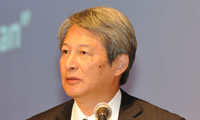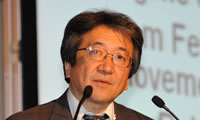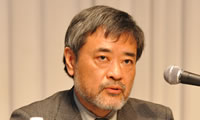Political Change in the Middle East:
Civil-military Relations, Democratization, and International Commitment
January 31, 2012, (Tuesday)
B2F, Room "Daigo", Sheraton Miyako Hotel Tokyo
>>Event Guide/Program
Organizers: IDE-JETRO, The World Bank, The Asahi Shimbun Company
Keynote Address1 | Keynote Address2 | Panel Discussion(1) | Panel Discussion(2)
Part 2 Panel Discussion
Moderator:
Takashi Shiraishi (President, IDE-JETRO)
Panelist:
Eiji Nagasawa (Professor, Institute for Advanced Studies on Asia, The University of Tokyo)
Hitoshi Suzuki (Senior researcher, Area studies center, IDE-JETRO)
Ali Ferdowsi (Professor and Chair, Department of History and Political Science, Notre Dame de Namur University)
Keynote speakers (Lisa Anderson and Cyril Muller) will also join the panel.

Takashi Shiraishi (President, IDE-JETRO)
Eiji Nagasawa (Professor, Institute for Advanced Studies on Asia, The University of Tokyo)
The January 25 Revolution in Egypt was the country’s first “revolution” since the revolution of July 1952. Following the events of January 25, Egypt has entered a period of upheaval. Comparing the January 25 Revolution with the July 1952 Revolution, historically there are three similarities, namely the impact of the military, the Muslim Brotherhood, and the influences of the United States. In the revolution of July 1952, the military brought about a change in the regime. The latest upheaval was similar in terms of the intervention of the military. However, the January 25 Revolution saw the military assume the more of the role of a coordinator, with young people playing a significant role. I believe that this new generation will play a crucial role in Egypt’s society and economy, in addition to merely political processes.
The January 25 Revolution will not end with the establishment of a new political regime. Rather, from a long-term perspective, the events of January 25 will carry a historical significance. The January 25 Revolution has also had an undeniable impact on political conditions throughout the Arab region. We have already seen new developments in Palestine. Meanwhile, some believe that the four countries of Egypt, Iran, Saudi Arabia and Turkey will exert a larger influence in the Middle East region after the events of the Arab Spring. At present, the influence of the United States is diminishing in the Middle East. In this context, I expect Japan to develop cooperative bilateral ties more actively with the region’s new governments as an impartial and balanced outsider.

Eiji Nagasawa
(Professor, Institute for Advanced Studies
on Asia, The University of Tokyo)
Hitoshi Suzuki (Senior researcher, Area studies center, IDE-JETRO)
Iran’s nuclear issue emerged as a concern about 10 years ago. However, new tensions have flared up since the end of 2011. An IAEA report issued in November suggested the remaining possibility of nuclear weapons development in Iran. The U.S. responded by announcing tighter sanctions. Iran responded in turn by alluding to a blockade of the Strait of Hormuz. To assess the situation, I would like to take a look at two indicators. The first is the exchange rate for Iran's currency, rial , and the second is the changes in the crude oil prices. The tightening of sanctions has caused the Iranian rial to plummet in value, just meaning that the size of Iran's economy has been effectively reduced to less than half of its previous level. Meanwhile, we have not seen any large movements in crude oil prices in response to the statement of the Strait of Hormuz blockade. Consequently, having attempted to drive up crude oil prices by suggesting such a blockade, Iran has now inevitably backed itself into a corner.
Every time an oil issue arises, response measures become an urgent priority of Japanese foreign and energy policy. To alleviate this problem, Japan must diversify its crude oil imports from Persian Gulf states to other regions, including North African countries like Libya.

Hitoshi Suzuki (Senior researcher,
Area studies center, IDE-JETRO)
Keynote Address1 | Keynote Address2 | Panel Discussion(1) | Panel Discussion(2)

